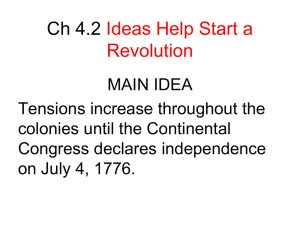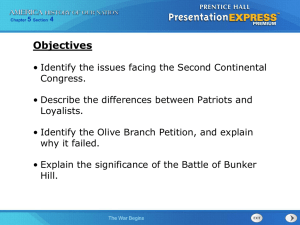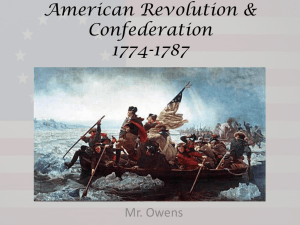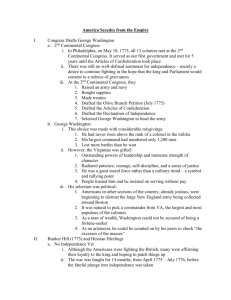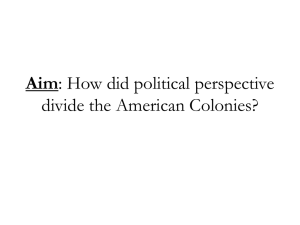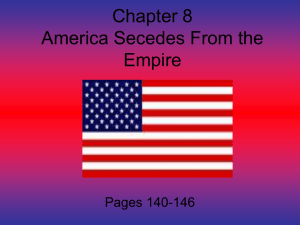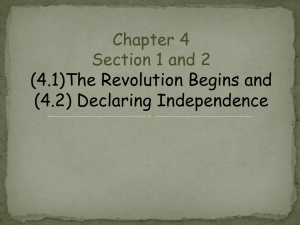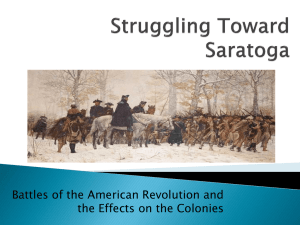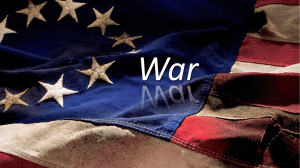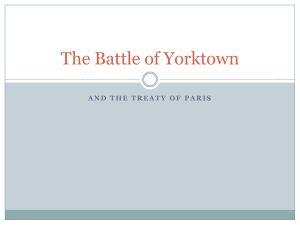Unit 2 pt. 8 - IB-History-of-the
advertisement
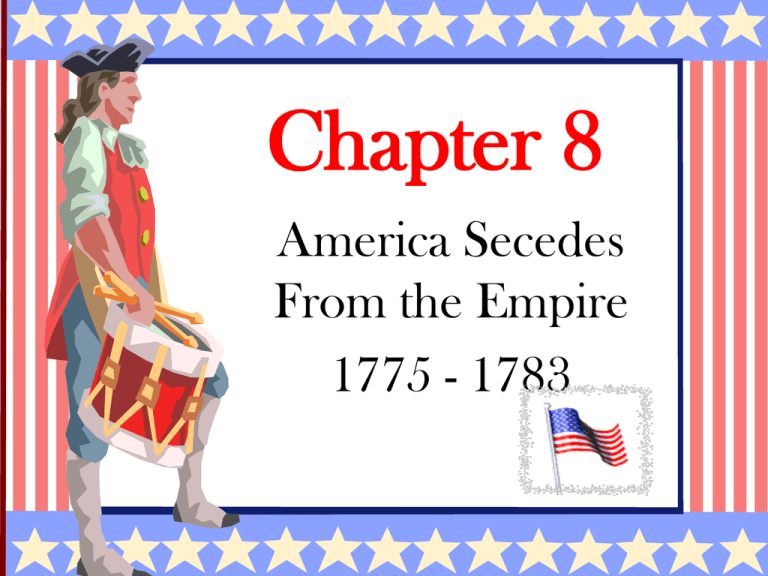
Chapter 8 America Secedes From the Empire 1775 - 1783 Emanuel Leutze's stylized depiction of Washington Crossing the Delaware (1851) April – May 1775 • 20,000 militiamen arrive in Boston after Lexington & Concord • May 10, 1775 – 2nd Continental Congress met in Philadelphia – No defined support for independence – Americans still hoped to get London to address their grievance Congress Drafts George Washington • GW chosen to lead “army” moving to Boston – VA planter & member of Congress – Important choice but there were many doubts • Had combat experience 20 years before • Never rose above rank of colonel • Largest command was only 1,200 • Not a military genius (lost more battles than he won) – Washington’s strengths: strong leader, strength of character, moral force, people trusted and were willing to follow him Second Continental Congress • Decisions: hired George Washington – Political, not military, decision • Army was mainly from New England; appointed Virginian to command to balance sections – Wealthy man (meaning he wasn’t after $$$) • Declaration of the Causes & Necessities for Taking Up Arms - when George III rejected Olive Branch Petition • Galloway Plan - keeping colonies in the empire w/ self-governing rights King George III Bunker Hill & Hessian Hirelings • April 1775 – July 1776: inconsistent war b/w BR & Americans – Americans affirmed loyalty to king while raising armies and fighting BR soldiers • May 1775: Ticonderoga & Crown Point – Americans under Ethan Allen & Benedict Arnold captured BR forts with important gunpowder & artillery supplies Bunker Hill & Hessian Hirelings • June 1775: Bunker (Breed’s) Hill – British strategy- split New England from other colonies (unsuccessful) – Colonists took hill overlooking Boston – BR should have flanked Americans – Instead, BR charged up hill with 3,000 • Americans firmly entrenched with 1,500 • Americans mow down BR until gunpowder ran out and they were forced to retreat • BR lose 1,100 men; Americans lost 300 – Called Battle of Bunker Hill but most fighting took place at Breed’s Hill Bunker Hill & Hessian Hirelings • June 1775: Olive Branch Petition – pledged loyalty and asked King to intercede w/ Parliament to secure peace and protection of colonial rights – Sent by Continental Congress to king – Americans professed loyalty to crown and asked for end of fighting – After Bunker Hill, London gov’t would not consider this • August 1775: king declared colonies in rebellion – Made colonists’ actions treason (punishment is death) • September 1775: king finalized deal to hire Hessians – Shocked colonists (king bringing in foreign troops) – Hessians were good soldiers, although many deserted to stay in America for land The Abortive Conquest of Canada • Fall 1775: colonists invaded Canada – Americans believed (wrongly) that FR wanted to kick BR out of Canada – Canada would become 14th colony and deprive BR of launching point for invasions of America – Contradicted colonists’ claims they were fighting defensive war – French had been treated well by BR (Quebec Act) and did not want to overthrow BR in Canada The Abortive Conquest of Canada • March 1776: BR forced to evacuate Boston • 2 American victories in South – Feb: Moore’s Creek Bridge (fighting Loyalists) – June: Charleston harbor against invading BR fleet • Moves toward independence came slowly – Loyalty to BR deeply ingrained – Colonial unity was poor – Open rebellion was dangerous Thomas Paine Preaches Common Sense • Events that moved Amer toward independence came slowly – Harsh BR attacks (burning of towns) – Hiring of Hessians – January 1776: Common Sense – “no country should be controlled by an island” • • • • • One of the most influential pamphlets ever written Thomas Paine came from BR only 1 year earlier Sold 120,000 copies in only a few months King was “the Royal Brute of GB” Called for independence AND the creation of a new gov’t – a republic – Power comes from people, not the king – All public officials should be responsible to the people – Supported by colonists who saw king’s actions after 1763 as conspiracy to take away their liberties – The Crisis – “These are the times that try men’s souls. The summer soldier and the sunshine patriot will shrink from the service of their country “ (check Ch. Intro) Paine and the Idea of “Republicanism” • Colonists’ gov’t prepared them for republicanism – Colonists practiced with town meetings & annual elections – Committees of correspondence – America had no fixed hierarchy of power • Republican virtue – Sacrifice personal self-interest for the public good Jefferson’s “Explanation” of Independence • June 7, 1776: RH Lee (Virginia) moved for independence – “These colonies are and of right ought to be free and independent states” • July 2, 1776: Lee’s resolution passed after much debate – Needed a more formal declaration and explanation • June 1776: committee prepared formal declaration – TJ wrote it (“world’s greatest editorial”) – July 4, 1776 it was formally approved by Congress • “all men are created equal” • “natural right” that King George had violated, so colonists were justified in rebellion • • The Declaration of Independence Jefferson “borrows” many ideas from John Locke in writing the Declaration of Independence. The Declaration of Independence has three main goals: – to explain the political philosophy of the colonists – to list the grievances of the revolutionists – to formally declare their separation from Britain Locke’s Influence • Reasoned that while the state (gov’t) is supreme, it is bound to follow “natural laws” based on the rights that people have simply because they are human. He argued that sovereignty ultimately resides with the people rather than with the state. Furthermore, citizens had a right and an obligation to revolt against whatever gov’t failed to protect their rights. • • Impact of the Declaration: – – – Established colonies as rebels, not BR subjects trying to reconcile Allowed America to realistically request foreign aid Influenced many others in struggle for freedom in the future “We must indeed all hang together, or, most assuredly we shall all hang separately” John Trumbull, 1817 Patriots and Loyalists • Loyalists (“Tories”) – – – – – – • People in America loyal to the crown 16% of population Upper classes, generally older People who worked for the king in colonies Anglican church members (except in Virginia) Strong in NYC, Charleston, Quaker Penn, NJ Patriots (“Whigs”) – – – – • People who fought for revolution Patriots fought not only BR soldiers, but also Loyalists during the war Generally younger colonists Strongest in New England (Presbyterians & Congregationalists, strong tradition of self-gov’t, support for mercantilism weakest) Revolution supported by only minority of the population (many were neutral) Needed support of citizens • – – BR didn’t do this well Patriots used “political education” to get support of undecided colonists Patriots and Loyalists • • • Persecution of Loyalists – Mild before Decl of Indep (tarring & feathering) – Harsher after Decl of Indep (viewed as traitors by patriots) • Persectued, imprisoned, hanged 80,000 driven out or fled (estates confiscated to pay for war) 50,000 fought for BR General Washington at Bay • March 1776: BR evacuated Boston & used NY as HQ (many loyalists, good port, central location) • Summer-Fall 1776: disaster for Americans – Battle of Long Island: Americans retreat in panic – BR General Howe lets Washington retreat instead of stopping his army • Washington heads into NJ – December 26, 1776: captured 1,000 Hessians sleeping off Christmas celebrations at Battle of Trenton after crossing Delaware River at night – January 1777: defeated BR forces at Princeton Emanuel Leutze's stylized depiction of Washington Crossing the Delaware (1851) Flag had not been designed yet Washington would have overturned the boat! No ice on the Delaware River Washington crossed at night, so there would have been no light! Burgoyne’s Blundering Invasion • 1777 – BR plan to capture Hudson River Valley – Would cut off New England – General Burgoyne would come S from Canada; Howe would come N from NY – General Benedict Arnold stops the BR advances • Holds Burgoyne off until winter sets in • Burgoyne’s 7,000 troops moved S slowly & were attacked repeatedly by militiamen – Howe instead goes S to attack Philadelphia (hoped to destroy Washington’s army) Burgoyne’s Blundering Invasion • Howe settled in for winter at Philly • Washington makes camp at Valley Forge, 20 miles NW of Philly – Miserable winter, men freezing – Baron von Steuben turned them into a professional army • October 17, 1777: Saratoga – Burgoyne forced to surrender to Washington and Lafayette look over the troops at General Horatio Gates Valley Forge. – Strengthened rebel cause – Allowed FR to enter war on American side – Turning point! Revolution in Diplomacy? • FR & America seemed ideal partners • FR: – Wanted to get back at BR for loss in 7 Years’ War – BR would not be a world power w/out the colonies • America: needed help against BR • Continental Congress wanted to end colonialism & mercantilism – Wanted no political connection, no military connection, only a commercial connection – Benjamin Franklin negotiated treaty w/FR – Feb. 1778: Franco-American Alliance • Official recognition from FR of America’s independence • America received important military aid from FR (guns, troops, navy, $$$, equipment) • Both would fight until America received independence & both agreed to terms w/BR • FR declared war on BR • 1779: SP & HOL enter war against BR • Armed Neutrality organized: demanded respect from BR for freedom of seas (passive hostility) Blow and Counterblow • 1778: change in BR strategy – Before: blockade & control coast w/powerful navy – After: FR navy threatened blockade – BR evacuated Philly & concentrated on NY – Washington uses army to hold BR at NY • Late 1780: General Benedict Arnold turned TRAITOR! – – – – Felt he was not appreciated Promised to sell out West Point Plan detected at last minute and stopped Arnold fled to BR • New BR plan: take S first (where Loyalists were strong) then move N – Overrun Georgia, then SC surrendered • Many Indians fought w/BR (to stop American expansion) – – – – Iroquois Nation divided Chief Joseph Brant led pro-BR Iroquois Attacked Penn & NY until stopped by Americans Treaty of Ft. Stanwix (forced to sign, gave away most of their land) Land & Sea Frontiers • Kentucky – Lexington named for Mass. town where fighting began – Louisville named for FR King Louis XVI “I have not yet begun to fight” • BR scattered forts in W are vulnerable • American navy: a few small ships led by daring officers – John Paul Jones – Never made a dent in BR navy – Main contribution was hurting BR merchant shipping • American privateers: privately owned armed ships (legal pirates) – – – – Authorized by Congress to attack enemy merchant shipping Out for patriotism & profit (kept what they stole) Brought in gold, hurt the enemy, raised morale Led BR merchants to pressure Parliament to end war Yorktown and the Final Curtain • 1780-1781: darkest period of war for America – Continental dollars almost worthless (inflation) – Gov’t bankrupt – Mutiny & despair prevailed • Cornwallis marched into a trap at Yorktown – Unsuccessful operations in VA – Fell back to Yorktown (Chesapeake Bay) to wait for supplies (but FR controlled the seas at this point) – Joint American-FR operation at Yorktown – Cornwallis trapped at sea by FR & at land by Washington – October 1781: Cornwallis & 7,000 men surrender • FR had provided the essential sea power & ½ of troops for America ** David Bushnell- The Turtle, first sub, 8 small windows; egg-shaped; 1 person, 3 mph; submerged for 30 minutes. – Used once during Revolution, targeted HMS Eagle Final Curtain - Yorktown (Oct. 19, 1781)- George Washington & Cornwallis Surrender of Cornwallis at Yorktown (John Trumbull, 1797). On the right is the American flag, on the left is the white flag of the French monarchy. Despite the painting's title, Cornwallis (claiming illness) was not present and is not depicted. Washington is on horseback in the right background; because the British commander was absent, military protocol dictated that Washington have a subordinate—-in this case Benjamin Lincoln-—accept the surrender. Peace at Paris • King George planned to continue fighting (still had 54,000 troops in N.A.) • Fighting continued for a year – Washington kept army in the field and the states together or else an acceptable peace treaty might never have been signed • BR public sick of war (losses around the world) • March 1782: Lord North’s Tory gov’t collapsed – Replaced by Whigs (anti-king, anti-war) • 3 Americans in Paris to negotiate peace – B. Franklin, J. Adams, J. Jay – Congress instructed them to consult w/FR but they wanted to make the best treaty for the US, not FR • FR wanted independent US, but not a powerful one • Tried to confine the US to east of Allegheny Mountains • SP also wanted area east of Alleghenies – John Jay believed FR were about to betray US, so made secret communications w/BR, who quickly agreed – 1783: final Treaty of Paris signed Treaty of Paris 1783 • Results of Treaty – U.S. • BR recognizes independence • Generous boundaries – Mississippi on West – Great Lakes to N – To SP Florida in S • Kept control of important fishing areas in Newfoundland – Britain • cedes Florida to Spain • Loyalists not persecuted in US • Congress would recommend that their confiscated property be restored • States would pay debts to BR debtors – Debt issues not carried out in future by US, leading to future conflicts w/BR Painting by Benjamin West depicting (from left to right) John Jay, John Adams, Benjamin Franklin, Henry Laurens, and William Temple Franklin. The British commissioners refused to pose, and the picture was never finished. A New Nation Legitimized • Why did BR give America such a good deal??? – Wanted to break Franco-American alliance – Whig gov’t (only in power for a few months) more friendly to America than Tories • Wanted to repair the relationship, reopen trade, prevent future wars w/America • FR formally approved Treaty of Paris – Wanted to bring costly war to an end • America is the only country that gained from the Revolution – BR defeated – FR incurred massive debt FR Revolution – America gained independence and their country Personality Profiles • ** Major Andre- everybody liked him (even G. Wash), plans found in boots Personality Profiles • John Hancock – “so King George can see it w/o his spectacles” – smuggler/merchant believed he should be commander in chief • ** Patrick Henry – “Give me liberty or give me death” • Alexander Hamilton- born in West Indies; G. Washington’s aide Patrick Henry Alexander Hamilton
